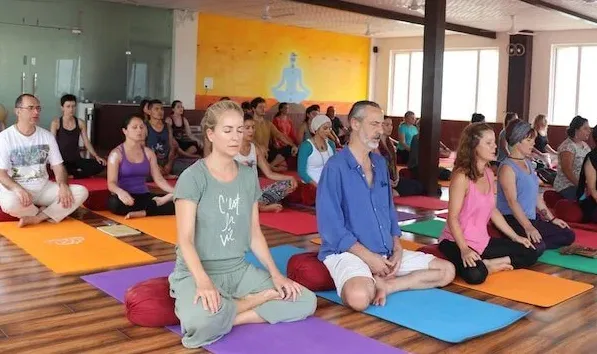How did 'yoga', the ancient exercise of body and soul, spread around the world?
Although the
world was well aware of the ancient Indian physical and spiritual practice of
‘Yoga’ for a long time, when the United Nations recognized the invaluable
services of this ancient Indian tradition in 2014, June 21 began to be
celebrated as International Yoga Day and for the first time in 2015, ‘Yoga Day’
was celebrated from New York to Seoul, Kuala Lumpur and New Delhi.
Ten years
after this first celebration, we are examining what ‘Yoga’ or ‘Yoga’ is and how
it was introduced around the world.
Although the
history of Yoga is not clear, it can be said that its traces are clearly found
in India before the time of the founder of Buddhism, Mahatma Buddha. Therefore,
some of its asanas were used and emphasized in Buddhism to control the body and
mind.
Read more
If we define
it simply, it can be said that yoga is a mental and physical practice, that is,
yoga is a process of promoting physical and mental health, which includes
physical postures, breathing techniques and meditation.
The word
‘yoga’ is derived from the Sanskrit word ‘yuj’ which means ‘to unite’, ‘to
join’ or ‘to join’. Its aim is to harmonize the body, mind and spirit.
Generally,
it is an exercise of the body and spirit in which the body is bent and held in
different postures and it also includes controlling breathing and exhalation.
Therefore,
we can call it a process of physical and spiritual discipline.
In this, the
body is practiced to make it flexible, build strength and establish balance,
and for this, the body is kept in different postures.
It has three
major parts: one is the physical postures called ‘asana’, the second is the
breathing techniques called ‘pranayama’ and the third is meditation called ‘dhyana’.
Through
this, a person can improve his mental and physical health, but it is said to
require a lot of discipline.
On the
website of the Ministry of External Affairs of India, Dr. Ishwar V. Basavaraj
has written in praise of it that ‘Yoga is essentially a spiritual discipline
based on a very subtle science, which focuses on bringing harmony between the
mind and the body. It is an art and science of healthy living.’
Richard
King, while praising it in 1999, said that ‘Yoga in its traditional sense is seen
throughout South Asia and beyond, which includes many techniques that lead to
spiritual and moral purification of the self. Hindu and Buddhist traditions
alike place great emphasis on the practice of yoga. According to Hindu belief,
their god Shiva or Shiva is the first yogi, or yoga guru, but the credit for
introducing this Indian tradition to the world is given to the 19th-century
Hindu philosopher Swami Vivekananda, who first mentioned it during his address
at the World Religions Conference held in Chicago on September 11, 1893, and
then wrote a book titled ‘Raj Yoga’ in 1896, in which he described it as a
means of freeing the soul from the body through meditation.
Her
philosophy became very popular in the West, but the credit for making it
popular in the West goes to three yogis, or yoga gurus.
One of them
was Indra Devi, who was born in Russia. She is said to have introduced yoga to
America and given it a foothold there.
Her
childhood name was Eugenie Peterson. Her mother was Russian and her father was
Swedish. It is said that Eugenie's interest in India began at the age of 15
after reading a book by Rabindranath Tagore.
She traveled
to India in 1927 and became interested in yoga at a time when yoga was
dominated by men. She was one of the first women to be taught yoga by Sri
Tirumalai Krishnamacharya at the behest of the Raja and Rani of Mysore.
After the
death of her husband, she went to America, where she began teaching yoga. His
students included Hollywood stars Greta Garbo and Jennifer Jones.
He also took
yoga classes in Shanghai before his death in 2002, which was the first such
attempt in the new China.
B.K.S. Enger
is also considered to be one of the people who popularized yoga in the West.
Enger also studied yoga with Krishnamacharya and his students spread yoga
around the world.
He founded
an organization called ‘Inger Yoga’ and in 1966 wrote a book called ‘Light on
Yoga’, which is considered a seminal work on the subject. Mary Palmer, the
mother of yoga instructor Mary Dunn, arranged for Inger to travel to the United
States. Dunn later became known for teaching ‘Inger Yoga’ to thousands of
students.
In the
1970s, a yoga guru named Bikram Choudhary began teaching yoga, consisting of 26
yoga asanas. He was teaching yoga to Americans in 40-degree heat, and his yoga
was once very popular among Americans.
Today, you
can find yoga classes outside India, from Iran to the Arab region. With the
popularity of social media, so many videos of it have started coming out that
it becomes difficult for you to choose which method of exercise is best for
you.
Along with
this, now people have started telling ‘Yoga Man’ as the cure for all kinds of
diseases, saying that if you do such and such an asana, you will get rid of
such and such a disease. But instead, it would be better if you contact your
doctor about any ailment. Yoga is not only an exercise but has become a
business, but its serious followers are also benefiting from its benefits.




Post a Comment